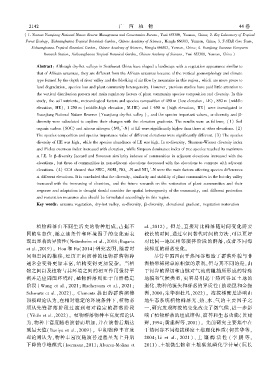Page 158 - 《广西植物》2024年第11期
P. 158
2 1 4 2 广 西 植 物 44 卷
( 1. Yunnan Yuanjiang National Nature Reserve Management and Conservation Bureauꎬ Yuxi 653300ꎬ Yunnanꎬ Chinaꎻ 2. Key Laboratory of Tropical
Forest Ecologyꎬ Xishuangbanna Tropical Botanical Gardenꎬ Chinese Academy of Sciencesꎬ Mengla 666303ꎬ Yunnanꎬ Chinaꎻ 3. T ̄STAR Core Teamꎬ
Xishuangbanna Tropical Botanical Gardenꎬ Chinese Academy of Sciencesꎬ Mengla 666303ꎬ Yunnanꎬ Chinaꎻ 4. Yuanjiang Savanna Ecosystem
Research Stationꎬ Xishuangbanna Tropical Botanical Gardenꎬ Chinese Academy of Sciencesꎬ Yuxi 653300ꎬ Yunnanꎬ China )
Abstract: Although dry ̄hot valleys in Southwest China have shaped a landscape with a vegetation appearance similar to
that of African savannasꎬ they are different from the African savannas because of the vertical geomorphology and climate
type formed by the depth of river valley and the blocking of air flow by mountains in this regionꎬ which are more prone to
land degradationꎬ species loss and plant community heterogeneity. Howeverꎬ previous studies have paid little attention to
the vertical distribution pattern and main regulatory factors of plant community species composition and diversity. In this
studyꎬ the soil nutrientsꎬ meteorological factors and species composition of 450 m (low elevationꎬ LE)ꎬ 850 m (middle
elevationꎬ ME)ꎬ 1 250 m (middle ̄high elevationꎬ M ̄HE) and 1 650 m (high elevationꎬ HE) were investigated in
Yuanjiang National Nature Reserve (Yuanjiang dry ̄hot valley )ꎬ and the species important valuesꎬ α ̄diversity and β ̄
diversity were calculated to explore their changes with the elevation gradients. The results were as follows: (1) Soil
-
organic carbon (SOC) and nitrous nitrogen (NO  ̄N) at LE were significantly higher than those at other elevations. (2)
3
The species composition and species importance value of different elevations were significantly different. (3) The species
diversity of HE was highꎬ while the species abundance of LE was high. In α ̄diversityꎬ Shannon ̄Wiener diversity index
and Pielou evenness index increased with elevationꎬ while Simpson dominance index of tree species reached its maximum
at LE. In β ̄diversity Jaccard and Sorenson similarity indexes of communities in adjacent elevations increased with the
elevationsꎬ but those of communities in non ̄adjacent elevations decreased with the elevations to compare with adjacent
- +
elevations. (4) CCA showed that SWCꎬ SOMꎬ NO  ̄N and NH  ̄N were the main factors affecting species differences
3 4
at different elevations. It is concluded that the diversityꎬ similarity and stability of plant communities in the hot ̄dry valley
increased with the increasing of elevationꎬ and the future research on the restoration of plant communities and their
response and adaptation to drought should consider the spatial heterogeneity of the communityꎬ and different protection
and restoration measures also should be formulated accordingly in this region.
Key words: savanna vegetationꎬ dry ̄hot valleyꎬ α ̄diversityꎬ β ̄diversityꎬ elevational gradientꎬ vegetation restoration
植物群落由不同生活史的物种组成ꎬ占据不 al.ꎬ2012)ꎮ 但是ꎬ直接对比群落随时间变化需要
同的生态位ꎬ随立地条件和环境因子的变化而表 较长的时间ꎬ通过空间替代时间的方法ꎬ可以更好
现出显著的异质性(Nettesheim et al.ꎬ2018ꎻBagaria 对比同一地区相邻演替阶段的群落ꎬ或者不同海
et al.ꎬ2019)ꎮ Hou 和 Fu(2014) 研究表明ꎬ随着时 拔梯度的群落变化ꎮ
间和空间的推移ꎬ经历正向演替的植物群落物种 尽管中国西南干热河谷塑造了群落外貌与非
通常会变得更加丰富ꎬ结构变得更加复杂ꎮ 当植 洲热带稀树草原相似的景观ꎬ但与其不同的是ꎬ由
物之间以及植物与其环境之间的相互作用保持平 于河谷的深切和山脉对气流的阻挡所形成的特殊
衡并适应周围环境时ꎬ植物群落则处于自然稳定 地貌和气候类型ꎬ更容易引起干热河谷区土地的
阶段 ( Wang et al.ꎬ 2021ꎻ Macheroum et al.ꎬ 2021ꎻ 退化、物种的流失和群落的异质性( 欧晓昆和金振
Schwartz et al.ꎬ2022)ꎮ Clements 提出的群落演替 洲ꎬ2000ꎻ朱华和杜凡ꎬ2022)ꎮ 海拔梯度是影响山
顶极理论认为ꎬ在相对稳定的环境条件下ꎬ植物必 地生态系统植物群落光、热、水、气的主要因子之
须从先锋群落阶段过渡到相对稳定的群落阶段 一ꎬ研究发现海拔的变化改变了微气候ꎬ进一步影
(Yildls et al.ꎬ2022)ꎮ 植物群落物种丰富度理论认 响了植物群落的组成结构、演替和生态功能( 黄建
为ꎬ物种丰富度随着演替而增加ꎬ并在演替后期达 辉ꎬ1994ꎻ黄建辉等ꎬ2001)ꎮ 先前研究主要集中在
到最大值(Baniya et al.ꎬ2009)ꎮ 中期物种丰富度 干热河谷不同海拔梯度土壤理化性质( 何其华等ꎬ
理论则认为ꎬ物种丰富度随演替过程呈先上升后 2004ꎻLi et al.ꎬ 2021 )、 土 壤 酶 活 性 ( 李 鹏 等ꎬ
下降的单峰模式( Isermannꎬ2011ꎻAlvarez ̄Molina et 2011)、土壤微生物和土壤碳氮磷化学计量( 阮长

